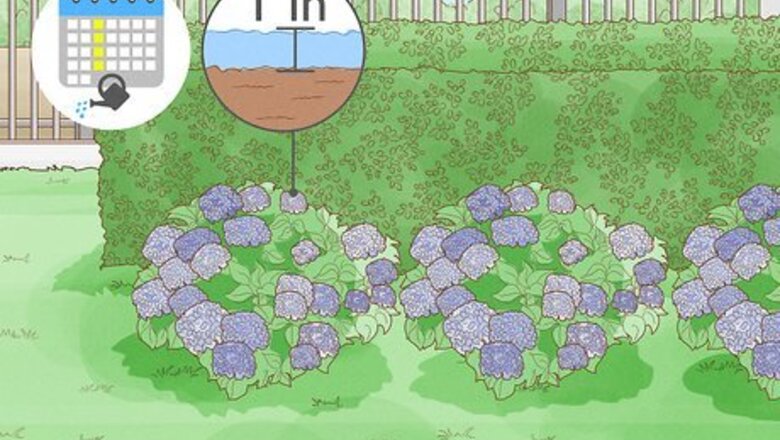
views
- Plant hydrangeas in front of your boxwoods for a classic combination. Their vibrant color contrasts perfectly against evergreen boxwoods.
- If you have tall boxwood shrubs, periwinkles are ideal because they only require partial sun.
- To border your boxwoods, plant lamb’s ear or creeping thyme. They're low-spreading varieties that add structure to any landscape!
Hydrangeas
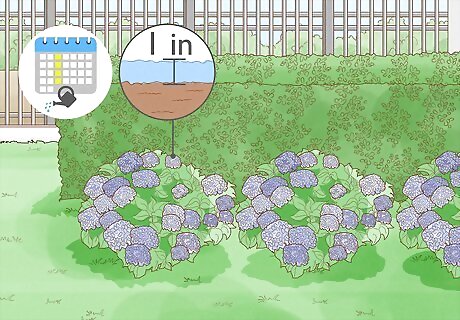
Hydrangeas are a classic companion for boxwoods. Choose this shrub for a relatively low-maintenance gardening experience. Their vibrant flowers come in an array of colors (white, pink, purple, and blue) that contrast beautifully with evergreen boxwoods. Make sure to pick a smaller variety, like smooth hydrangeas, to maintain balance in your landscape. Water: Give your hydrangeas 1 inch (2.5 cm) of water per week. Sun: Plant your hydrangeas in a partially-shaded location. Soil: Hydrangeas can adapt to poor soil conditions, but they thrive in rich, acidic soils.
Lily of the Valley
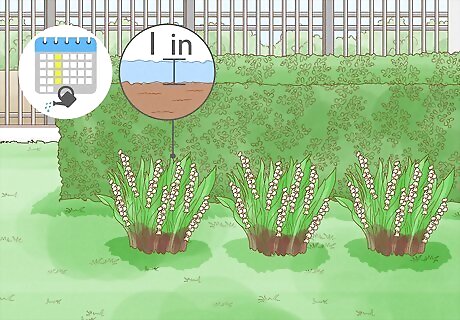
Lily of the valley is a delicate accent for softer boxwood landscapes. For an English country-inspired garden, plant lily of the valley for a sweet fragrance and romantic feel. They are low-growing (6-10 inches tall) but can spread aggressively (up to 2 feet), so don't be deceived by their dainty flowers! Water: Lily of the valley prefers moist soil that isn’t too wet. Depending on the climate, add 1 inch (2.5 cm) of water weekly and adjust water levels by sticking your finger in the soil. The soil should cling to your finger. Soil: Plant lily of the valley in acidic to neutral pH soil with good drainage. It typically doesn’t require fertilizer unless your soil lacks nutrients. If so, add granular fertilizer in the springtime. Sun: Plant lily of the valley in an area with shade or partial shade.
Periwinkle
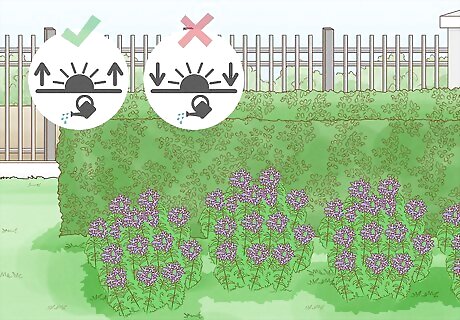
Use periwinkle as a colorful carpet in front of your boxwoods. Also called vincas, these vibrant, heat-tolerant plants are known for their pinwheel-like flowers. They come in red, pink, purple, or white and grow relatively low to the ground (3-6 inches). Try adding periwinkle as a ground cover in front of your boxwoods–their flowers add a pop of color to monochromatic landscapes! Water: Water your periwinkles regularly until the top 1-2 inches of soil are dry. Avoid watering late in the day to ensure your soil has a chance to dry out at night. Soil: Periwinkles thrive in rich soil with low salinity and good drainage. Try adding aged manure or compost to improve your soil quality. Sun: Plant your periwinkle in an area with partial to full shade. Their leaves yellow in full sun.
Liriope
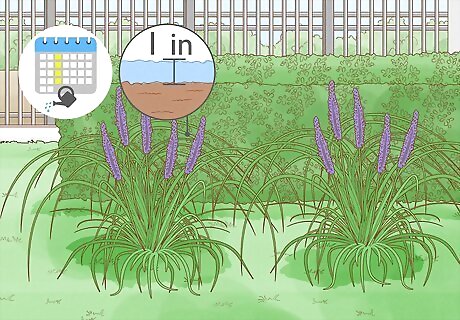
Plant liriope in front of your boxwoods to add depth. Paired with trimmed boxwoods, liriopes (lilyturf) add sharp texture and depth to your garden. They don’t grow tall enough to overpower your boxwoods (9-18 inches tall, 12-24 inch spread), but their spiky flowers are sure to grab your guest’s attention! Water: Give your liriope plant 1 inch (2.5 cm) of water per week. Soil: Liriope needs sandy or clay soil that drains well. Sun: Liriope does best in partial shade, but they also tolerate full sun or full shade.
Celosia
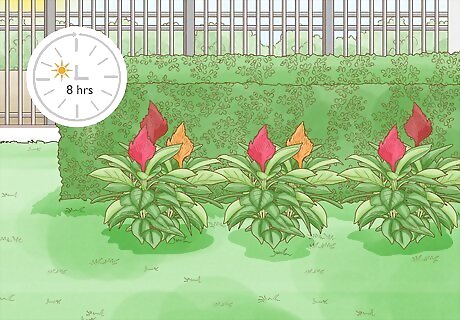
Celosias have striking spirals that complement shaped boxwoods. Known for their flame-like appearance, celosias are the perfect plant to mimic the shape of conical boxwoods. They typically grow 8-24 inches tall and should be spaced 8-12 inches apart. Plant the “forest fire” variety to add a bold pop of crimson color! Water: Be careful not to overwater your celosias! Water your plant moderately and evenly, stopping when the top inch of the soil feels dry. Soil: Plant your celosias in rich soil that drains well. Sun: Celosias need about 8 hours of direct sunlight to thrive, although they can tolerate a little shade.
English Lavender
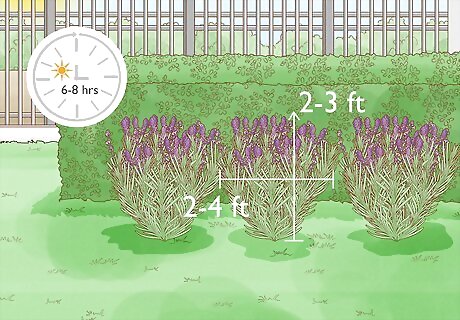
Plant English lavender next to your boxwoods for a calm atmosphere. Compared to other lavender varieties, English lavender doesn’t require as much sunlight. They’re an ideal size to plant beside boxwoods (2-3 feet tall, 2-4 feet wide), and their aromatic purple flowers have a relaxing scent. Plant them beside your front entrance or walkway for an inviting welcome! Water: Lavender is especially sensitive to insufficient water. Make sure you give your plant a deep soaking, especially through its first growing season. Soil: Plant your English lavender in dry, sandy soil that drains well. To avoid soggy soil, try mixing your soil with compost or limestone to improve drainage. Sun: Lavender requires full sun exposure to thrive. Scout out the sunniest areas in your garden to plant your lavender, and aim for your lavender to reach 6-8 hours of sunlight per day.
Lamb’s Ear
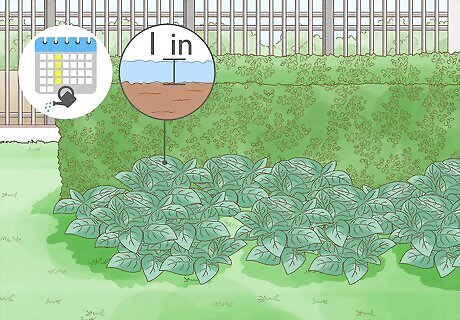
Add lamb’s ear to soften the border of your boxwoods. Plant lamb’s ear to add warmth and texture to your garden. Their fuzzy silver foliage grows 12 inches tall and spreads 30 inches wide. Since it can tolerate below-freezing temperatures, it’s the perfect choice for wintertime! Water: Don’t overwater your plant! Lamb’s ear is sensitive to overwatering so only water 1 inch (2.5 cm) per week. Soil: Plant your lamb’s ear in slightly acidic, well-draining soil. You can treat it similarly to an herb! Sun: Lamb’s ear prefers full sun in cooler climates.
Corsican Mint
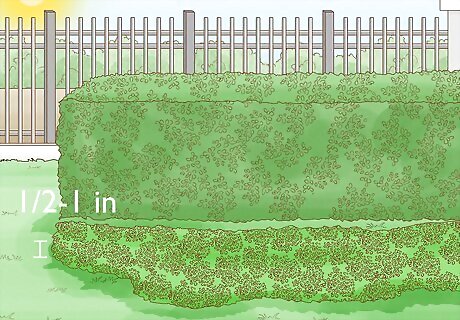
Plant Corsican mint beside your boxwoods for a fresh burst of fragrance. Under the right growing conditions, Corsican mint is an effective aromatic ground cover. It only grows ½-1 inch tall, but its strong scent helps repel garden pests and rodents. Plant Corsican mint next to stepping stones or walkways for a truly sensory experience! Water: Too much water can lead to root rot so water your Corsican mint moderately. Soil: Plant your Corsican mint in rich soil that drains well. Sun: Corsican mint thrives in full sun, but it can also adapt to partial shade.
Hostas
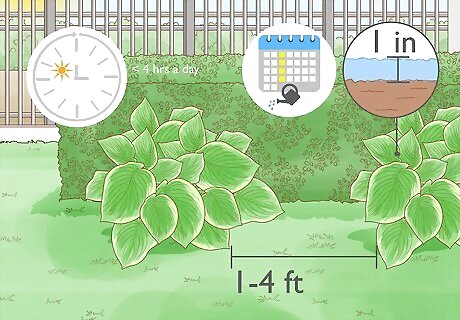
Hostas prefer shady areas beside boxwood shrubs. As boxwoods grow, they can shade and harm other plants in your garden. Hostas, however, thrive in shady areas! Their leaves come in green, gold, and blue and become lighter with increased sunlight. Aim to plant your hostas in the spring and place them 1-4 feet apart to ensure they have enough room. Water: Give your hostas 1 inch (2.5 cm) of water per week. It’s better to water them deeply and infrequently, instead of shallowly and frequently. Soil: Hostas can survive in a range of soils, but they prefer rich, well-draining soil that is high in organic matter. Try adding compost or aged manure to improve soil structure! Sun: Hostas prefer dappled shade, but they can also tolerate deep shade (less than 4 hours of sun per day).
Creeping Thyme
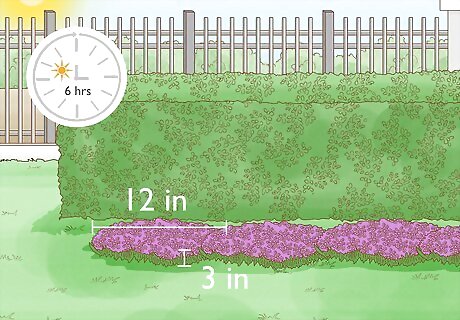
Creeping thyme forms a mat-like spread to perfectly border boxwoods. Also known as the “mother of thyme”, this perennial has low, dense coverage (3 inches tall, 12 inches wide) that complements the linear style of trimmed boxwoods. Creeping thyme can withstand busy walkways so it’s perfect to frame your boxwoods or add between stepping stones! Water: Creeping thyme tolerates drought, so you only need to regularly water them until they are established. Soil: The key to creeping thyme is soil that drains well! Plant your thyme in sandy or rocky soil to prevent root rot. Sun: Creeping thyme thrives with full sunlight (at least 6 hours) so avoid this plant if your boxwoods are large and/or tall.
Sweet Alyssum

Sweet alyssum can sweeten your boxwood arrangement. The honey-like fragrance of their flowers attracts pollinators, and they work well as an edging plant or ground cover. Sweet alyssum is typically white but also comes in vibrant blends (lavender, apricot, lemon). Place them along a walkway so their flowers “spill” over, or cascade them down a slope in a rock garden! Water: Give your sweet alyssum 1 inch (2.5 cm) of water per week. To prevent root rot, make sure the soil is thoroughly dry between waterings. Soil: Plant your sweet alyssum in soil that drains well. Too much fertilizer will promote more foliage growth than flowers. Fertilize lightly. Sun: Plant the seeds in full or partial sun, then make sure your sweet alyssum gets at least 6 hours of sun per day.


















Comments
0 comment